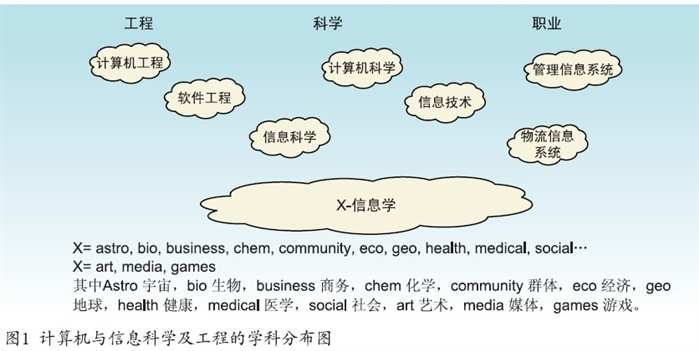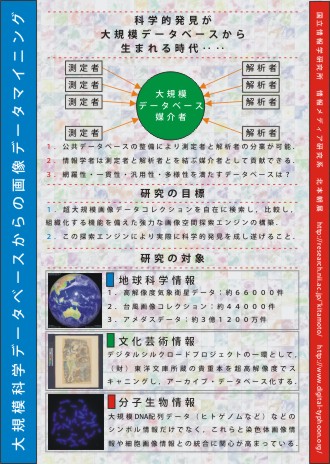在“第二届中美计算机科学峰会”(博主注: 2008年7月底)上,伊立诺伊大学阿贝纳香槟分校的马克·斯厄尔(Marc Snir) 教授作了题为“Computer & Information Science & Engineering - What's All This?” 的主题报告,引发了大家对于当前计算机与信息科学学科的发展道路的研讨。马克·斯尼尔教授站在学科的"工程一科学职业"布局角度,给出了计算机与信息科学及工程学科的分布(如图1所示) ,并特别强调随着信息学与其他学科的交叉形成了许多新的信息学领域“X-Informatics”。(博主注: 转载于徐晓飞: 美国大学计算机与信息科学的跨学科发展,中国计算机学会通讯,2009年第2期,下载地址:http://www.ccf.org.cn/web/resource/cccf/200902/0902-4.pdf)

1. Summary
These days, we often heard about "X-informatics", or the name of the research fields with the suffix "informatics," among which the most notable one is "bioinformatics." These fields share the same traits: they all aim at acquiring new viewpoints and models by applying informatics-based approaches to existing fields such as biology. They also share the same methodology: the generation of huge amount of data with the help of advanced sensor and observation technologies, and the fast search and knowledge discovery from large-scale databases.
2. X-informatics

These days, we often heard about "X-informatics", or the name of the research fields with the suffix "informatics," among which the most notable one is "bioinformatics." These fields share the same traits: they all aim at acquiring new viewpoints and models by applying informatics-based approaches to existing fields such as biology. They also share the same methodology: the generation of huge amount of data with the help of advanced sensor and observation technologies, and the fast search and knowledge discovery from large-scale databases.
In order for this approach to work effectively, we need to have as much data as possible, because the justification of this approach relies on the collection of "fact" that really occurred in the world. If we have more data, then we can draw more reliable conclusion. However, it does not mean that we simply should have more data; moreover, we need to have a data-collecting strategy for collecting many data with high quality,
Another important research issue is the construction of database for managing huge amount of collected data. Bioinformatics may be the most advanced research area in terms of using huge-scale databases as the infrastructure of research. The public databases are collecting sequenced genome data from all over the world, and other researchers access to these databases to download interested data and use them for their own purposes. This kind of research style based on data will be more and more popular in other scientific disciplines.
However, the utilization of computers in scientific disciplines is itself not at all new. Changes unique to recent movement can be described as "From computational-X to X-informatics," or in other words, from simulation technology to database technology. We can compare those two approaches schematically as follow.
X-informatics : Research on "What is this?"
Computational-X : Research on "How this will be?"
Then we can imagine the combination of approaches based on the research on "What is this?", namely X-informatics (database technology), and develop the research on "How this will be?", namely computational-X (simulation technology). This combination, in short, leads to a new scientific approach with the effective combination of observational facts and theoretical predictions. Moreover, if those large amount of data can be shared among many experts using Grid, for example, we many be able to establish a new scientific approach with the effective usage of networks.
3. Related Pages
4. References (Complete List)
Asanobu KITAMOTO, "Knowledge Discovery from Very Large Scientific Databases: "Digital Typhoon" Project as a Case Study", Monthly Seminar, National Institute of Informatics, 2002-09 [ Abstract ]
Asanobu KITAMOTO, "Mining and Searching for the Large-scale Collection of Typhoon Image Sequences", Proceedings of the 65th National Convention, IPSJ (Information Processing Society of Japan) Special Track, Vol. 5, pp. 255-258, 2003-03 (in Japanese) [ Abstract ] [ PDF ]
5. Related Links
National Center for Biotechnology Information
A huge database of biological information.
http://www.ncbi.nlm.nih.gov/
Sloan Digital Sky Survey
The astoronomical survey project by the comprehensive observations of celestial objects.
转载本文请联系原作者获取授权,同时请注明本文来自章成志科学网博客。
链接地址:http://blog.sciencenet.cn/blog-36782-223433.html
上一篇:冯志伟:《语料库语言学与计算语言学研究丛书》 序 【转载】
下一篇:中信所第五期青年学术沙龙:文献标引与领域词汇获取相关主题





















 5292
5292











 被折叠的 条评论
为什么被折叠?
被折叠的 条评论
为什么被折叠?








